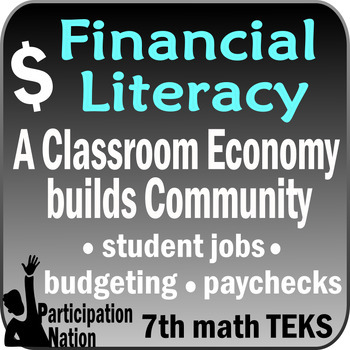Financial Literacy: a Classroom Economy builds Community - 7th TEKS
- Google Drive™ folder

Description
FINANCIAL LITERACY – CREATE A CLASSROOM ECONOMY & BUILD COMMUNITY - YEAR LONG
(loosely based on the program by Thom Gibson)
INTRODUCTION:
Goals:
1) Teach student’s financial literacy and build a strong community by allowing them to participate in a classroom economy.
2) Don’t overload the facilitator while accomplishing goal 1 or take up too much learning time.
Why Implement this System?:
- It fulfills several 7th grade TEKS for financial literacy and gives you a context in which to teach the others ( 6 assignments: Budgeting X2 , Taxes, Interest, Online Banking, Student Job Application ).
- It increases classroom cohesiveness and gives the class more of a sense of community.
- It helps students understand why financial literacy is important in the real world.
- It makes the facilitator/teacher’s job easier because of the support jobs students do.
- It largely runs itself once it is implemented.
- It takes up little learning time.
- It helps with behavior management because:
- Students ideally form the behavioral standards themselves and therefore buy in to them more than if they are imposed from above.
- There are fines for behavioral infractions.
- It is relatively easy – all the handouts, paperwork, and systems are already created for you. They can be found in the accompanying folder.
Overview of system:
- Students apply for jobs in the classroom by filling out a brief job application. Jobs are assigned by the facilitator. Every student has a job. Many of the jobs are support jobs to make the facilitator’s job easier.
- Students are paid a monthly salary for their job which is automatically deposited in a simulated online banking system (software is free).
- Students pay rent on their desks/chairs/seats but are encouraged to save their money so they can buy the desk and eliminate the monthly expense.
- Students pay fines for misbehavior in the classroom.
- A monthly class auction which takes about 15-20 is another place students spend money.
- Students can earn bonus money by donating items to the auction, completing external community service which is documented, or other activities instructor decides on. Bonus $ accounting takes 10-15 minutes of class time a month.
- Bankers (one of the classroom jobs) keep track of, add, and monitor bonus $ and only come to the teacher if there is a problem.
- Free Budgeting software is used. All students complete a spending plan at the beginning of the year. (2 assignments included)
- This system can be expanded to include taxation, mortgages, entrepreneurship, inflation etc. if desired.
In Classroom Time budget: minimum – 25 minutes of class time monthly plus several 10 minute sessions to set up the system/train students at the beginning of the year
- Students can check their online balances as desired and should not have to ask the teacher.
- 15-20 minutes monthly for auctions
- One 10 minute Banker sessions monthly for bonus $ and accounting
- Some jobs may require extra time at lunch to accomplish for the students but the facilitator can decide if they want to include jobs like this or not.
- Some jobs produce a product or service which is delivered in 1-2 minutes at the beginning or end of class but the facilitator can again decide if they want to include these.
This package includes 26 files (6 assignments) including:
1) A detailed explanation for the facilitator which includes descriptions of included add-ons like income-tax, entrepreneurship, mortgages, & inflation (the facilitator chooses if they want to implement these extras or not).
2) A list of suggest Materials
3) Documents for the bankers such as bonus $ guidance
4) A Volunteer form to earn bonus $.
5) A Charity Letter to Parents & a Charity Certificate (students can donate to charity)
6) A business proposal form.
7) Suggested Fines for Behavioral Issues
8) A guide to GoodBudget (the free online budgeting software) & 2 assignments
9) A guide to MyKidsBank (the free online banking system - can print bank notes)
9) An Inflation exercise with an assignment.
10) Job descriptions, a job application, a jobs worksheet for the facilitator, a jobs flier to post in the classroom & job icons for use in any other materials you might generate (job application can be used as assignment)
11) A Mortgage Agreement, Desk Deed, and Compound Interest assignment.
12) Simplified income Tax documents including W-2, 1040 form, and business income form (use tax form as assignment).


